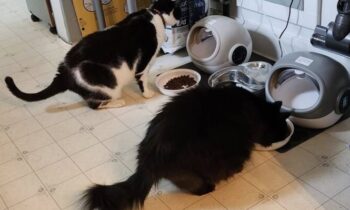
![]()
![]()
Several weeks ago, my big dog had to have surgery on one back paw, as a result of a nail infection.
Our veterinarian recommended that my dog wear, during his recovery, an Elizabethan collar.
You’re wondering why our vet wanted my dog in a fancy dress costume?
Google “Elizabethan collar historical” and you will see illustrations of neckwear fashions that are most often associated with Elizabethan England. These white collars, sometimes called ruffs, were worn from the late Tudor era to the reigns of the Stuarts, approximately the 1560s to the 1630s. Google “Elizabethan collar veterinary” and you will see how Elizabethan collars for pets got their name!
(Note: Very recently, manufacturers and users of electronic collars have been referring to their collars, which have been traditionally called shock collars, as E-collars. Those collars are remotely controlled and activate a pulse that the dog feels on its neck, in an ascending level of discomfort. These are not the same as veterinary Elizabethan collars and should not be mistaken for them.)
Why would your veterinarian prescribe the Elizabethan collar for your pet?
Here’s an article with some great perspectives on why vets choose to use it:
The Dreaded E-Collar: Why It’s Your Best Bet for Wound Care
http://www.vetstreet.com/our-pet-experts/the-dreaded-e-collar-why-its-your-best-bet-for-wound-care
My veterinarian wanted my dog in an Elizabethan collar because he knew that device would be most likely to prevent the dog from interfering with the bandage for the ten days to two weeks it took his paw to heal.
My dog could easily reach that paw if he were not prevented from doing so; he could tear the bandage off with his teeth, he could chew out the stitches. That sort of interference could be a serious step backward in his recovery from surgery!


Photo by Val Hughes
I borrowed an inflatable collar from a friend. My dog wore it willingly while we waited for his surgery date. I also borrowed a traditional translucent Elizabethan collar, which I “introduced” to my dog, but only as an object near him. My dog was not pre-trained to wear an Elizabethan collar.
I’m sad to say that I did not take the time I had from the day of his diagnosis to the day of his surgery to acclimate him to moving around, at least, with the Elizabethan collar on. I should have had him wear it for longer and longer in the weeks before his surgery. I should have given him a chance to learn to relax in it, to relax enough that he could sleep in it—to be comfortable “living” in it!
I foolishly did not anticipate how critical to his recovery the cone of shame would be.
I am extremely lucky that he did not object to wearing it. At least, he didn’t object enough to attempt to tear it off his big brown head! True, some very unwise buffaloing around took place when he first had it on. In hindsight, I know I should have started him out in a much safer space, especially without access to the stairs. He freaked, in a minor way, and it was dumb of me to allow it.
He should have been on leash in a harness at that point.
He and I are both lucky that he did not hurt himself. That was surely due to his good sense, not mine. I did not behave very wisely at all. He was back on the bed, looking befuddled, in no time. In retrospect, I now know that the wearing of this particular cone was only the beginning.


Photo by Val Hughes
Can you train your dog to accept willingly the wearing of a cone? I think you could, using positive methods and a whole lot of patience (yours and the dog’s!). But you can’t control what happens when the dog has to wear the cone for real . . . when it’s veterinarian’s orders. That’s going to happen when your dog is not his normal, healthy self. It will happen when he’s hurting, itching, healing—when wearing the cone can’t be anywhere near as rewarding as not wearing the cone because your dog can have no comprehension of “This is what’s good for you.”
I think your best bet is to shoot for “fear free.”
Dogs that have never seen a traditional translucent Elizabethan collar might possibly be frightened of the first one they notice, even it’s just sitting on the floor in front of them. It happens!
I’d be delighted to see puppy classes include “cones of shame” in their “dress-up” sessions, where puppies experience various articles of apparel they might wear in the future, with an appropriate introduction for a positive outcome. Puppies would not actually wear these items during the class sessions. Instead, they would “meet” the cones at their own pace, choosing to investigate or interact only if they wish. The goal: puppies see a variety of “cones” as “safe” objects.
For adult dogs, you could replicate that experience at home with a “cone of shame” bought at a yard sale or borrowed from a friend. Introduce the cone positively by allowing the dog to make up her own mind that it is a “safe” object. Let the cone become something your dog sees around the house. Pair the cone with something your dog finds rewarding. Place her favorite toy in the same room with the cone, move it closer as your dog shows how she “feels” about the cone. Watch her body language!
Once your dog is familiar with the cone as a “safe” object, consider preparing prior to the time she is spayed or he is neutered. Train your dog positively to wear the collar comfortably before it’s needed. Do the same if you have some lead time before any scheduled surgery that might require cone-wearing during the recovery period. Do your dog and yourself a big favor by being proactive!
Here’s an article and video on training your dog to accept wearing the collar willingly:
The ‘Cone of Shame’: How to Help Your Dog Feel Comfortable Wearing an Elizabethan Collar
https://www.preventivevet.com/dogs/how-to-help-your-dog-feel-comfortable-wearing-a-cone
Whether you’ve been proactive and trained your dog ahead of time to feel comfortable in that collar, or even if your dog has not set eyes on an Elizabethan collar ever, the time may come when, ready or not, you’re going to have to put that collar on your dog and keep it there, for his own good.
And for your own good.
You’ll be worried about your dog. You’ll be worried about the cost of the veterinary care. You’ll be worried about supervising the recovery without losing your job or your sanity. I know, I’ve been there. I am still there right now. It is not easy. It is very difficult and there’s no way around that.
You don’t know what you don’t know.
Here’s some general information as well as the history of the E-collar:
Elizabethan collar
https://en.wikipedia.org/wiki/Elizabethan_collar
This article suggests a variety of alternatives to the Elizabethan collar:
Alternatives to the Cone of Shame
https://www.petmd.com/dog/care/alternatives-cone-shame
Next week, how I found out that the Elizabethan collar I’d borrowed was not the right size for my dog, plus ideas for helping your dog to relax and to cooperate while he’s wearing that darn cone!



